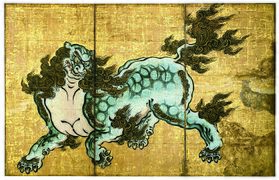Kanō Sanraku
Kanō Sanraku ( Japanese 狩 野 山 楽 , actually Kimura Heizō ( 木村 平 三 ), then Mitsuyori ( 光 頼 ); born 1559 in Kyōto ; died September 30, 1635 ) was an important Japanese painter of the late Momoyama and early Edo periods . He founded the Kyō branch (Kyōto branch) of the Kanō school .
Live and act
Sanraku's father was Kimura Nagamitsu, a high vassal of Azai Nagamasa ( 浅井 長 政 ; 1545–1573), daimyo of the Ōmi province , who, in addition to his service, was busy with painting and encouraged his son to do so. After the fall of the Azai in 1573, Toyotomi Hideyoshi served his father and son . Hideyoshi recognized Sanraku's talent for painting and sent him to Kanō Eitoku , who adopted him and named him Shurinosuke ( 修理 亮 ) as an apprentice . He soon supported his adoptive father and teacher in his painting projects.
When Eitoku collapsed sick with a wriggling dragon ( 蟠龍Banryū ) while painting the ceiling of the classroom of Tōfuku-ji in Kyōto , Sanraku completed the large painting on the orders of Hideyoshis, which strengthened his reputation at one stroke. After Eitoku's death in 1590, Sanraku and Eitoku's eldest son Mitsunobu ( 光 信 ; 1565-1608) became the leading artists of the Kanō school. Sanraku settled in Osaka and worked for Hideyoshi.
After Tokugawa Ieyasu's extermination of the Toyotomi family in 1615 , Sanraku was concerned for his own safety and had to go into hiding. But through the mediation of the monk painter Shōkadō Shōjō he was able to make peace with the ruling Tokugawa. He now settled in Kyoto, where he, supported by his adopted student Sansetsu ( 山 雪 ; 1590-1651) could continue to be artistically active.
When Tokugawa Hidetada rebuilt the Shitennō-ji temple in Osaka in 1623 , Sanraku painted the life story of the temple's founder, Prince Shōtoku, on six valleys that are kept in the temple's picture hall. In 1624 he painted walls in the rebuilt castle tower of Osaka Castle . In contrast to Tan'yū and Kanō Naonobu, however, he was not led by the Tokugawa as court painter ( 御用 絵 師 Goyō eshi ).
Sanraku's work is partly determined by the style of his stepfather, but he developed it further independently, painting more decorative and at the same time closer to nature. His work includes the paintings on sliding doors in Daikaku-ji in Kyōto: “Red plum blossoms” ( 紅梅 図 ), “Peonies” ( 牡丹 図 ) and “Falcon on a pine branch” ( 松 に 鷹 図 ), owned by the pair of screens the Nishimura family with eagle representations ( 鷲 鳥 図 ), the screen with the scene around car positions ( 車 争 Kuruma arasoi ) from the Genji Monogatari in the Tōkyō National Museum and a screen with the " Southern Barbarians " ( 南蛮 図 屏風 ), ie the Portuguese and Spaniards who landed in Nagasaki.
In his later years, Sanraku had a son, Mitsumori. But this died early, so that Sanraku's line was finally continued by Sansetsu, who married a daughter of Sanraku.
gallery
literature
- Suzuki, Toshihiko (Ed.): Kano Sanraku . In: NIhon daihyakka zensho (Denshibukku-han) . Shogakukan, 1996.
- Tazawa, Yutaka: Kano Sanraku . In: Bibliographjical Dictionary of Japanes Art . Kodansha International, 1982, ISBN 0-87011-488-3 .
- Tokyo National Museum (ed.): Kano-ha no kaiga. 1979.
Web links
| personal data | |
|---|---|
| SURNAME | Kanō, Sanraku |
| ALTERNATIVE NAMES | 狩 野 山 楽 (Japanese, stage name); Kimura Heizō (maiden name); 木村 平 三 (Japanese, maiden name); Kimura Mitsuyori (real name); 木村 光 頼 (Japanese, real name) |
| BRIEF DESCRIPTION | Japanese painter |
| DATE OF BIRTH | 1559 |
| PLACE OF BIRTH | Kyoto |
| DATE OF DEATH | September 30, 1635 |



